The Best Vanilla Buttercream Frosting {For Cookies + Cakes}
The best and easiest vanilla buttercream frosting, this is my go-to for cookies, cupcakes, and cakes. Light and creamy, it is fluffy and deliciously perfect.
I’ve made a lot of vanilla frosting over the years.
I’m actually a little bit of a frosting snob, if I’m telling the truth.
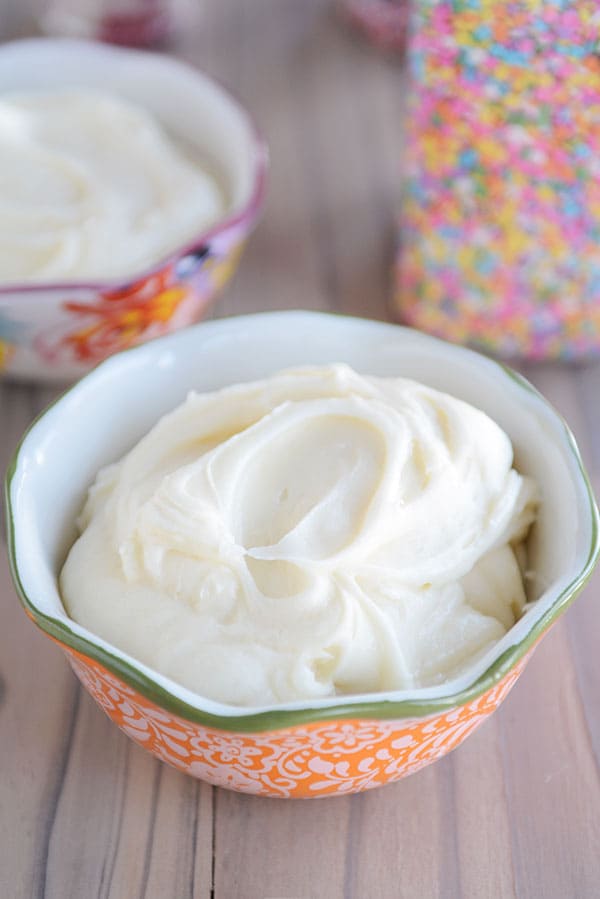
Given the choice, I’d take cake or cookies (Valentine’s sugar cookies, I’m so ready for you) over frosting any day, but since they’re almost always paired together, my frosting has to be perfect.
Greasy, tasteless, shortening-based frosting? Ick. Creamy, butter, fluffy frosting? Oh, baby.
I’ve referenced frosting many times over the years in specific recipes, but until today, classic vanilla buttercream frosting hasn’t had it’s own spot here. A real home, if you will.
This frosting is the one I turn to 99% of the time when I’m making cakes (you can see some of the cakes I’ve made my kids over the years on Instagram with the hashtag #melmakesherkidscakes) or frosting cookies or cupcakes.
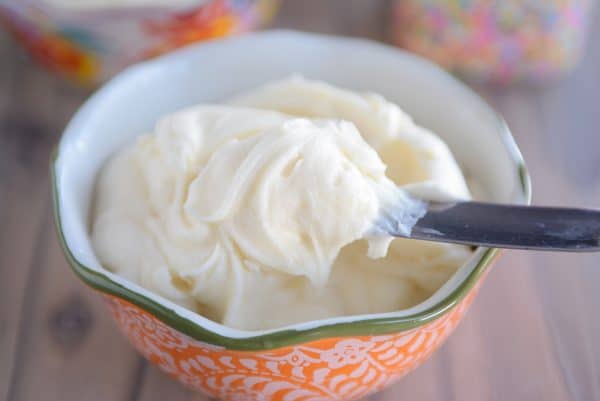
I’m an amateur, but it’s been fun (read: lots of late nights) trying new things with my self-taught cake decorating skills.
Another favorite frosting recipe I’ve talked about before is this quick vanilla buttercream – it’s delicious with a slight cream cheese flavor.
That’s certainly not a bad thing, but often, we love the buttery, creamy flavor of today’s fluffy, delicious vanilla buttercream frosting.
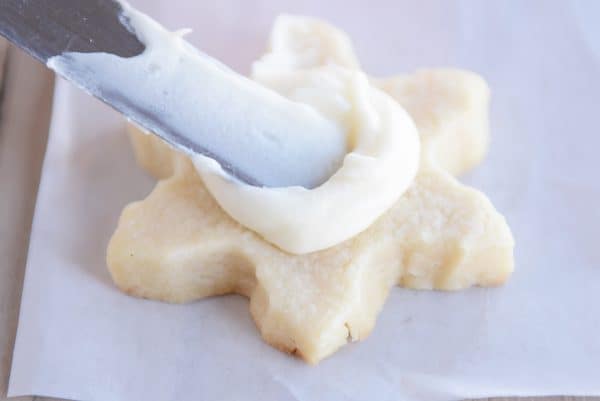
You can see by glancing at the recipe, it’s not rocket science.
In fact, the ingredient lineup is a pretty popular and oft-used ratio for frosting: 1 cup butter to about 4 cups powdered sugar with enough heavy cream or milk to get just the right consistency.
And of course, vanilla.
It’s the method that makes the magic for this vanilla frosting.
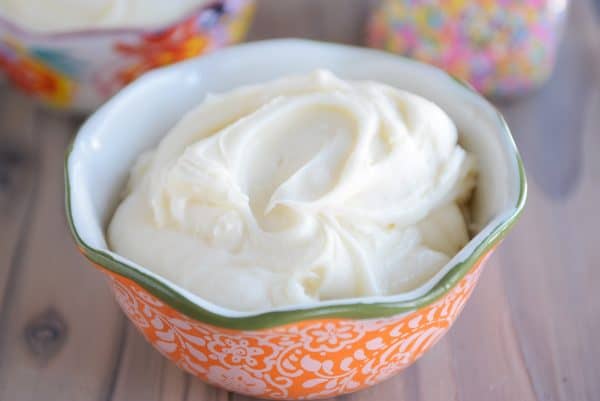
Whipping the butter until light and creamy in the first step is key. So don’t skip or skimp on that part, pretty please.
After adding the sugar, the frosting is creamed again for several minutes creating the lightest, fluffiest frosting you’ll ever met.
Let’s talk mixers for a second.
When it comes to mixers, I’ve made this vanilla buttercream frosting using my trusty handheld electric mixer, and it works great as long as you can stick with mixing it for several minutes and handle a bit of powdered sugar poof. I’ve had that hand mixer for years and it is a workhorse.
I’ve also waxed poetic about my Bosch mixer over the years…it is unparalleled for making breads and cookie dough and many other things, but frosting is not its strong suit, unless the recipe is doubled or tripled.
It pains me to say that because I love it so, but it’s the truth. I only use it for this frosting if I’m making a huge batch.
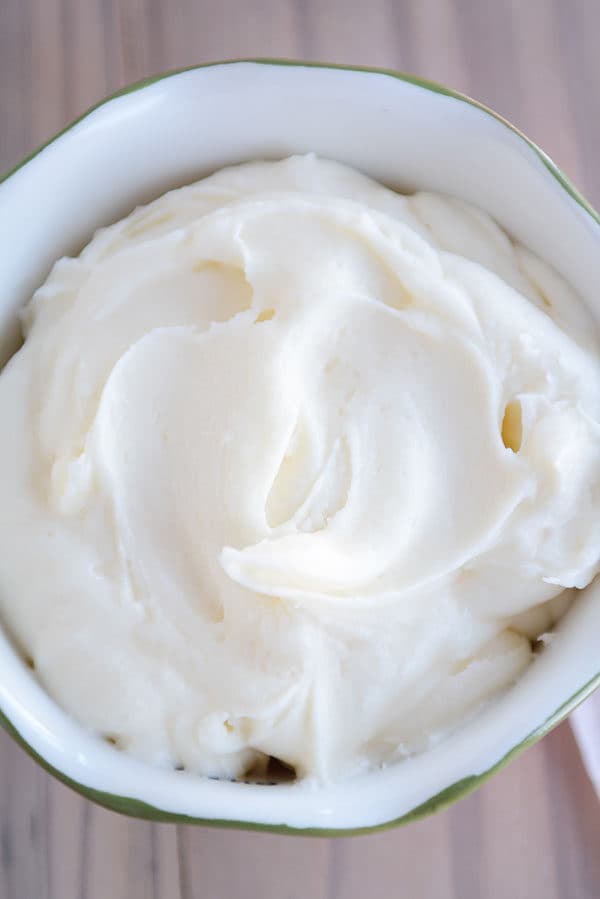
I finally buckled and bought a Kitchenaid mixer last year when Costco was running a rebate. I’m not going to lie, I felt like I was cheating on my beloved Bosch when I brought the shiny silver Kitchenaid home.
Although I don’t use it as much as I should (because I love my Bosch so very much), the Kitchenaid definitely shines with recipes like this frosting, especially if I’m diligent about scraping down the sides and bottom of the bowl.
A few notes:
- this frosting pipes really well (and you can add additional powdered sugar for a stiffer frosting)
- it is easily adaptable to a cream cheese frosting
- clear vanilla extract as a sub to pure vanilla extract can help achieve a lighter color of frosting
- when frosting sugar cookies, I like adding slightly more heavy cream than the recipe calls for (upwards of 6 tablespoons) so the frosting is extra creamy
- although a lot depends on how heavy-handed one is with frosting, this makes enough to lightly frost a two layer 9-inch cake or 24 cupcakes; I double or triple if I’m piping decorations or the cake is bigger
And let me give a quick plug to the best frosting spatula in the world. I use this 9-inch angled small spatula almost every time I frost cupcakes, cookies or a cake.
That little spatula (ok, I have two) is used all.the.time.
I have the larger version of the spatula for really big cakes, but the small one is a lifesaver; I never knew how easy it was to frost anything until I had one. The best $4 you’ll ever spend.
Phew! I think I’m done! Who knew I had so much to say about frosting?
One Year Ago: Winter Minestrone Soup with Garlic Bruschetta
Two Years Ago: Classic Strawberry Shortcake {With a Decadent Chocolate Version}
Three Years Ago: No-Bake Berry Yogurt Cheesecakes
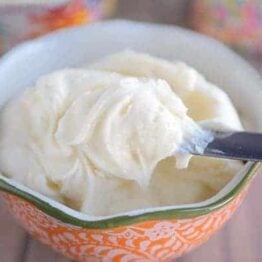
The Best Vanilla Buttercream Frosting
Ingredients
- 1 cup (227 g) butter (I use salted), softened to room temperature (see note)
- 1 teaspoon pure vanilla extract
- 4 cups (456 g) powdered sugar
- 2 to 4 tablespoons heavy cream
Instructions
- In a large bowl using a handheld mixer or the bowl of an electric stand mixer fitted with the paddle attachment, beat the softened butter and vanilla extract until the butter is light in color and creamy, about 3 minutes, scraping down the sides and bottom of the bowl as needed.
- Add the powdered sugar gradually, about 1/2 cup at a time, mixing completely after each addition and scraping the sides of the bowl often.
- Increase the mixer speed to medium-high, and continue mixing while adding the heavy cream (start with the lesser amount and add more as needed until the desired consistency is reached). Add more powdered sugar for a thicker frosting.
- Whip until the frosting is light and fluffy, about 3-4 minutes.
- If using food coloring, add it now (gel coloring is preferred so it doesn’t thin out the frosting), and mix until combined.
Notes
Recommended Products
Recipe Source: from Mel’s Kitchen Cafe

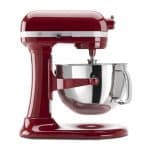
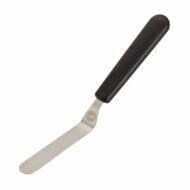
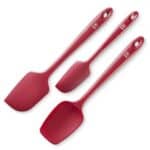
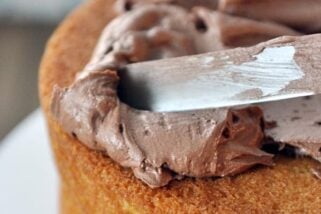
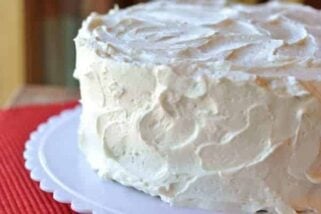
Do you have a frosting you recommend for sugar cookies that stacks well?
I don’t like the taste of royal icing or hard-set icings, so I usually use soft buttercream frosting for decorating cookies.
I made a homemade banana cake last weekend and used this recipe for the frosting. It was delicious! This icing is so yummy and has such a nice texture. I would happily frost any cake with this frosting. My sister made a ginger cake with no frosting, and I used a bit of this frosting on my piece of cake. It tasted amazing – similar to Jane Parker Spanish Bar Cake for those of you who remember that product. 🙂
Hi! I’m looking for a frosting that I can pipe swirls of onto large cookies, then let it set and wrap individually. Will this frosting work, or is there another one of yours that you’d recommend? Thank you! PS I love your White Velvet sugar cookies, they’re my go-to!
Hi Dawn, while this frosting does crust over a bit, it doesn’t harden enough to not get smushed, if that makes sense. As long as the cookies are loosely wrapped and stored in a single layer, it might work, otherwise you might need to try a stiffer-set frosting.
Turned out awesome!
Buttery and lite,
I plan on using this to frost cupcakes. Do the cupcakes need to be refrigerated after being frosted? I would prefer icing that doesn’t need Refrigeration of the Frosted items.
It really depends on how long the cupcakes will need to be out before being served – if it’s just a few hours, they don’t need to be refrigerated, but more than 4-5 hours and yes, I would refrigerate the cupcakes.
Mels,
I plan to use this recipe for our church as we are doing a Arts Camp ( Vacation Bible school ) for the children in the community. Our theme is Love Thy Neighbor. One of our crafts is making cookies and decorating them. Then we place in cookie baskets which we are making out of wooden berry baskets that the kids decorate and then they will give to a neighbor. Thank you.
comes out perfect every time I make it. And it taste delicious
First icing I ever made from scratch and it was a hit. Thank you
Perfect!! I was making root beer float cookies and I wanted to make a vanilla frosting that hardened like royal icing (but maybe not AS hard) but tasted delicious. Well, I came across your recipe and I am so glad I did. The cookies and frosting came out great! Your recipe was easy to make and it was exactly what I was looking for!! Thank you!
Also, I like to use plastic squeeze bottles for applying frosting and icing. I searched the comments to see if anyone had used them with this frosting and it seemed no one had commented on it yet. Well, I used the squeeze bottle and it worked okay. The only issue was the warmth of my hand eventually started to liquify the frosting so I just used a couple bottles (chilled a bit in refrigerator to help) and refilled with fresh frosting.
I will definitely be using this wonderful frosting again. Thanks again!!
I loved this icing recipe exactly how it’s listed. I made a double batch and prolly didn’t need to. We frosted about 50 something Christmas sugar cookies. With a bunch of frosting left over. Definitely saving this for next year!
Does this need to be refrigerated and how long will it last?
If you aren’t going to use it within a few hours, yes, it should be refrigerated. It should keep in the fridge for up to a week.
Does this icing crust well enough to package it?
It stays fairly soft.
Is it ok to use light cream instead of heavy cream?
Yes, that’s fine.